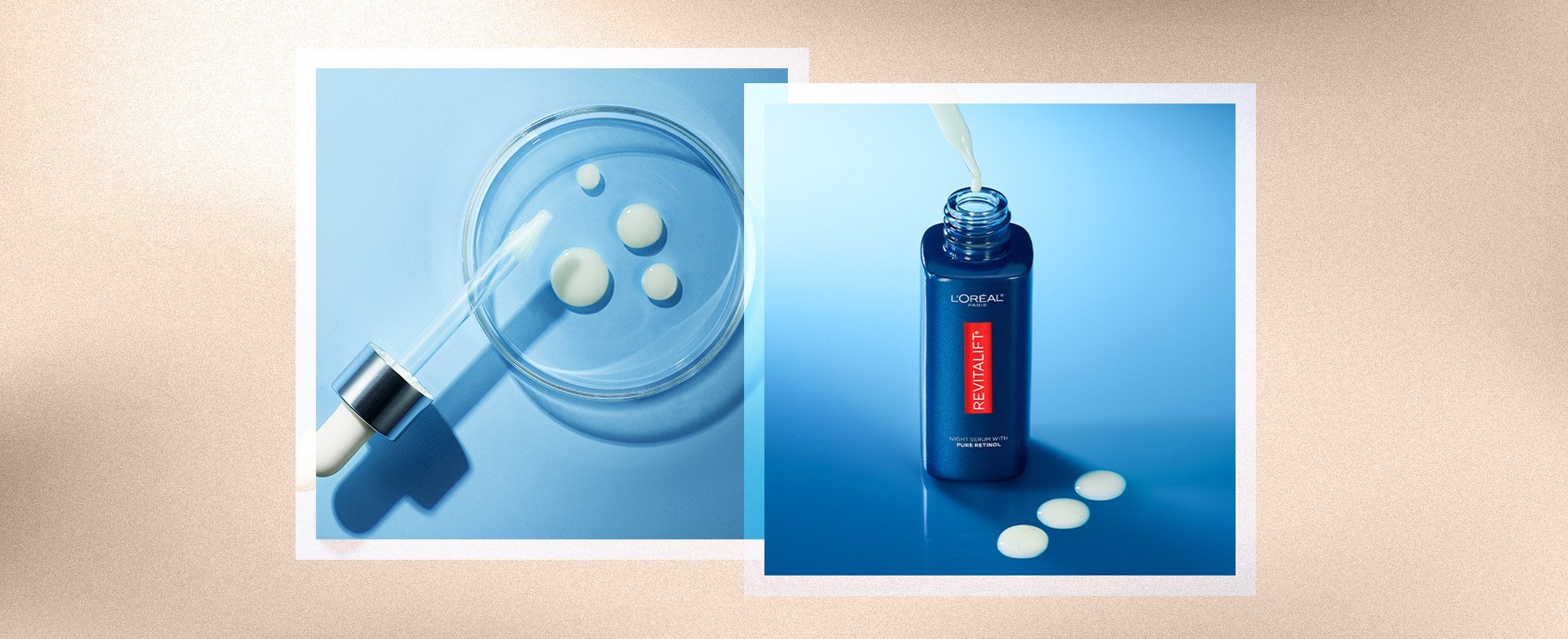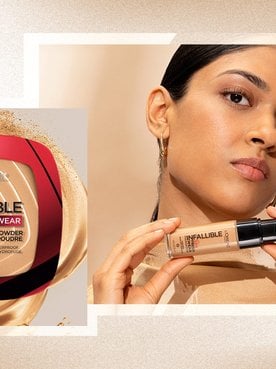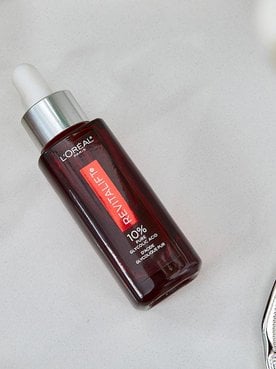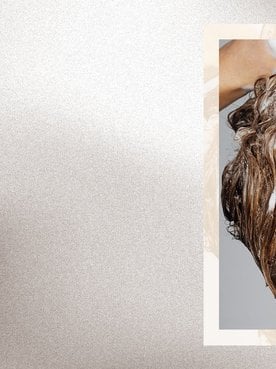In this article
- What Is Retinol?
- How Does Retinol Work?
- How to Use Retinol in Your Skin Care Routine
- Can You Use Retinol Daily?
- Can You Leave Retinol on Overnight?
- How Long Does It Take to See Results From Retinol?
- Can You Put Moisturizer Over Retinol?
- Our Favorite Over-the-Counter Retinol Products
- Are There Downsides to Using Retinol?
- Retinol Serum FAQs
Wrinkles may be a natural part of life, but if you’d like to soften their appearance, retinol serum is one of the most trusted options in skin care. This ingredient is celebrated for its ability to enhance clarity, brightness, and smoothness, making it a staple for anyone looking to support healthier-looking skin. Beyond the hype, many still wonder about retinol benefits for skin and specifically what does retinol serum do.
Keep reading to learn everything you need to know about retinol serums: the basics of retinol, how does retinol work on the skin, and how to use it safely. We'll also go through frequently asked questions and our top recommended products. Whether you’re new to retinol serum uses or looking to refine your routine, keep reading to learn how to get the most out of this powerhouse ingredient.
Shop the Products
What Is Retinol?
Retinol comes from vitamin A, a nutrient that supports healthy skin. You’ll find it in many over-the-counter creams and serums, and it belongs to a bigger family called retinoids. There are prescription-strength retinoids that are stronger and usually used for stubborn blemishes or deeper wrinkles under a doctor’s care. In contrast, retinol for the face over-the-counter formulas are gentler and easier to use at home for long-term skin maintenance.
When applied as a retinol serum, such as the L’Oréal Paris Revitalift Night Serum, 0.3% Pure Retinol, it gently pushes your skin cells to renew themselves more efficiently. This is why retinol is considered approachable yet powerful. It can help with early signs of aging, uneven tone, or breakouts without overwhelming your skin.

How Does Retinol Work?
Retinol increases cell turnover and stimulates collagen production, making it a favorite for those seeking anti-aging solutions. Among the many retinol benefits for skin, you can expect:
- Smoother fine lines and wrinkles, as retinol encourages skin to stay firm and plump.
- Clearer skin and fewer breakouts, since it helps keep pores unclogged.
- More even skin tone, with dark spots and discoloration fading over time.
- Refined texture, leaving your complexion softer and more radiant.
- Antioxidant protection, which helps shield your skin from everyday stress.
A retinol serum is the easiest way to incorporate these benefits into your skincare routine because it's lightweight and sinks in easily.
How to Use Retinol in Your Skin Care Routine
Using retinol serum requires a thoughtful approach. While the results are impressive, it can cause dryness and irritation if not introduced gradually. While you are using it, it is essential that you moisturize and mandatory that you use a 50+ SPF sunblock. Here’s how to add it to your regimen:
At night
Start slowly, applying a retinol serum for the face only one to two nights per week. This gives your skin time to adjust and minimizes the risk of peeling or redness. Over time, you can increase usage as your skin builds tolerance. Many dermatologists also recommend the “sandwich method,” where you apply moisturizer before and after retinol to buffer its intensity (it's also called the "buffering method"). This way, you can enjoy retinol benefits without the excessive dryness.
In the morning
Retinol makes your skin more sensitive to the sun, so SPF is non-negotiable. Always follow up your nighttime routine with a broad-spectrum sunscreen the next morning. A product like L'Oréal Paris RevitaLift Triple Power Moisturizer with SPF 30 protects against UV damage, while moisturizing and helping you maintain the results of your retinol treatment.

Can You Use Retinol Daily?
Yes, but only once your skin has adjusted to it. When you’re just starting out, it’s best to apply retinol serum once or twice a week, so your skin can get used to the ingredient without becoming overly dry or irritated. As your skin builds tolerance, you can slowly increase how often you use it, with many people eventually reaching nightly use. The key is to pay attention to how your skin feels and make changes if you notice any discomfort. Being patient will help you enjoy the full retinol benefits without setbacks.
Signs you’re overusing retinol
If your skin starts showing signs like redness, peeling, or persistent irritation, that’s your skin’s way of saying it’s had too much. This usually means you’re applying your retinol serum too often or using too strong a formula. To help your skin recover, ease up on retinol for a bit, focus on gentle cleansers, hydrating moisturizers, and soothing products, and reintroduce retinol slowly once your skin feels calm again.
Can You Leave Retinol on Overnight?
Absolutely. Retinol products are designed to be left on the skin as part of your overnight routine. In fact, this is when they work best, since sun exposure can reduce retinol’s effectiveness. For example, the L’Oréal Paris Revitalift Triple Power Anti‑Aging Moisturizer Fragrance‑Free is a little powerhouse that blends Pro‑Retinol (a gentle, stable form of retinol) with hyaluronic acid to deeply hydrate, and vitamin C to brighten your complexion while you sleep.
Shop the Products
How Long Does It Take to See Results From Retinol?
Patience is key with a retinol serum. While some retinol benefits, like smoother texture, may show up within a few weeks, the more noticeable changes, such as softer fine lines, fewer wrinkles, and brighter skin tone, usually take three to six months of consistent use. During this time, the ingredient is working beneath the surface to support collagen, repair past damage, and refresh your complexion.
Understanding how retinol works helps manage expectations: it’s not an instant fix, but with regular use, the long-term retinol serum benefits are worth it. If you’re still wondering what retinol serum does, think of it as training your skin to renew itself more effectively over time.
Can You Put Moisturizer Over Retinol?
Yes, and you should. Applying moisturizer after retinol helps seal in hydration and reduce potential dryness. For sensitive skin types, try the sandwich or buffering method: apply moisturizer, then retinol, followed by another layer of moisturizer. This creates a protective barrier while still allowing your skin to reap the retinol benefits.
Our Favorite Over-the-Counter Retinol Products
If you’re ready to add retinol serums and creams into your routine, over-the-counter options are accessible and effective. Here are three standout picks from L’Oréal Paris:
L’Oréal Paris Revitalift Night Serum, 0.3% Pure Retinol
This retinol serum contains a strong yet approachable 0.3% pure retinol, the highest concentration L’Oréal has released in an over-the-counter formula. That means it’s designed to visibly smooth wrinkles (even deeper ones), brighten dull skin, and improve firmness over time. Its lightweight, fast-absorbing texture is non‑comedogenic, fragrance-free, and dermatologist tested, making it suitable for most skin types.
L’Oréal Paris Revitalift Triple Power Anti-Aging Moisturizer Fragrance-Free
This moisturizer is formulated with pro-retinol, a gentler version of retinol that helps smooth wrinkles while being kind to the skin. Along with pro-retinol, it also contains vitamin C for brightness and hyaluronic acid for deep hydration, making it a multi-tasking cream that works on firmness, tone, and moisture at the same time. Its fragrance-free formula makes it a great option for those with sensitive skin who still want the benefits of retinol in a balanced, nourishing way.

L’Oréal Paris Revitalift Pressed Night Moisturizer with Retinol + Niacinamide
This innovative night cream comes in a hygienic, fresh‑pressed jar that makes it easy to use just the right amount every time. Instead of a heavy night cream, it's a lightweight, nourishing formula that layers comfortably. What makes it stand out is the blend of retinol with niacinamide, a skin-soothing powerhouse that helps keep the balance, so your skin doesn’t feel tight or dry during the night. With a 12% complex of calming ingredients, it delivers deep hydration. This means you may notice your skin feeling softer and more comfortable within the first day, and it stays hydrated for up to 24 hours.

Are There Downsides to Using Retinol?
Like all potent ingredients, retinol serums can have potential side effects. Common issues include dryness, redness, peeling, and temporary breakouts (sometimes called purging), especially when first introduced. To minimize these and still enjoy the many retinol benefits for skin, start slowly with your retinol serum uses, always follow with moisturizer, and never skip sunscreen.
Understanding how to use retinol properly helps ensure that you get the full range of retinol serum benefits while avoiding irritation. Remember, when it comes to retinol uses, less is more. Gradual steps are the safest way to discover what retinol serum does for your skin.
Shop the Products
Retinol Serum FAQs
Do dermatologists recommend retinol?
Yes, but always following guidelines. The American Academy of Dermatology suggests using a retinol serum for face because it’s a simple and effective way to help with early signs of aging and occasional blemishes. Dermatologists usually recommend easing into it slowly, letting your skin adjust at its own pace, and then increasing how often you use it once your skin feels comfortable.
Can you combine retinol with vitamin C or other actives?
It depends. Both retinol and vitamin C are strong, effective ingredients, but putting them on together can sometimes be a bit too much for the skin. A simple way to avoid irritation is to use vitamin C in the morning to brighten and protect, and keep your retinol for the evening so it can work while you sleep. If you’re trying them for the first time, do a patch test to make sure your skin stays happy with the combo.
Who is a good candidate for retinol?
If you’re in your late 20s or 30s, you’re at a great age to start adding retinol into your routine as a way to support your skin before deeper lines set in. It can be especially helpful if you’re dealing with small breakouts, the first signs of fine lines, uneven tone, or extra oiliness. If your skin is on the sensitive side, if you have rosacea, or if you’re pregnant, it’s best to check with a dermatologist first so you can use retinol in the safest way for you.
Next Up: How To Prevent and Treat Fine Lines Under Eyes
Photo courtesy of L’Oréal Paris







